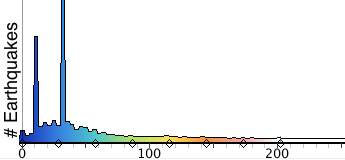Global Earthquake Depths
Earthquake depth is the measurement in kilometers of the sub-surface
depth of the source of the earthquake rupture. The source depth amd
planview location is commonly referred to as the earthquake
hypocenter. As shown in the illustration below for earthaquakes with
magnitudes 5.5 and greater between the years 1973 and 2009 the
greatest number of reported events has occured at relatively shallow
depths between 10 and 60 km. The maximum depth approaches 700 km.
Earthquakes occur in two settings:
-
along the fault planes where the rigid lithosphere edges
belonging to adjacent plates either slides past each other and
deforms under friction, or thrusts one under the other or rips
apart from each other. The Earth's lithosphere is the strong
outer skin (rind) between 10 to 100 km in thickness that breaks
in a mode of brittle failure. Rock that is not very warm retains
its strength and its brittle behavior. However, silicate
materials that form the earths mantle weaken with increasing
temperature to a threshold where the rocks then become ductile
and deform by flowage without breaking. Since temperature rises
in the earth's interior with depth, the mantle becomes
sufficently with increasing depth that earthquakes on plate
surfaces or edges can no longer gereated from friction-induced
brittle rupture.
-
In the interior of the lithospheric where lithosphere slabs descend
(subduct) into the mantle at convergent-type plate boundaries. Since the
slabs insert themselves into the ductile mantle at velocities of 50 to 200
km per million years, they can reach depths of hundreds of kilometers
before their interiors warm up sufficiently to inhibit brittle
deformation. Thus earthquake hypocenters between 100 and 700 km depth
are almost allways located within the interior of the subducting slab
and not along its edges or outer surfaces as in the shallower regimes.

There are substantially more earthquakes at shallow depths between 10 at
60 km than at deeper depths down to 700 km.

When the depths of earthquakes are compared to their magnitudes for the
global distribution as shown in the map, one observes two apparent
regimes of behavior. The decrease in magnitude with depth from 0 to 350
km in the shallower regime reflects the progressive weakening of rock
materials with increasing temperature and thus their potential to
release seismic energy when the material ruptures. In the deeper regime below
350 km, the increasing pressure transforms the original minerals into
new and more compacted (higher density) crystal phases of greater
strength. But eventually the material warms enough, even in its new
altered and stronger state, that it flows rather than breaks and earthquake activity
ceases altogether.
Deep earthquakes below 350 km are if interest because
thay are in fact quite common (almost 25% of all evens with magnitude
>5.5) and have relatively more impulsive sources than the shallow
events.
Further Reading:
Bonner, J.L., Blackwell, D.D, Herrin, E.T. Thermal constraints on
earthquake depths in California. Bulletin of the Seismological Society
of America; December 2003; v. 93; no. 6; p. 2333-2354; DOI:
10.1785/0120030041
Frohlich, C. The nature of deep-focus earthquakes. Annual Review of
Earth and Planetary Sciences, Vol. 17: 227-254 (Volume publication date
May 1989)
Griggs, T. The sinking lithosphere and the focal mechanisms of deep
earthquakes. In: E.C. Robertson, J.F. Hays and L. Knopoff, Editors, The
Nature of the Solid Earth, McGraw Hill, New York, N.Y. (1972), pp.
361–384.
Isacks, B., J. Oliver, and L. R. Sykes (1968), Seismology and the
New Global Tectonics, J. Geophys. Res., 73(18), 5855–5899,
doi:10.1029/JB073i018p05855.
Maggi, A., Jackson, J.A., McKenzie, D., Priestly, K. Earthquake
focal depths, effective elastic thickness, and the strength of the
continental lithosphere.. Geology June 2000 v. 28 no. 6 p. 495-498.
doi: 10.1130/0091-7613.
Tichelaar, B., and L. Ruff, Depth of seismic coupling along
subduction zones, J. Geophys. Res., 98, 2017-2037, 1993.
Weidner, D. J., and K. Aki (1973), Focal depth and mechanism of
mid-ocean ridge earthquakes, J. Geophys. Res., 78(11), 1818–1831,
doi:10.1029/JB078i011p01818.
